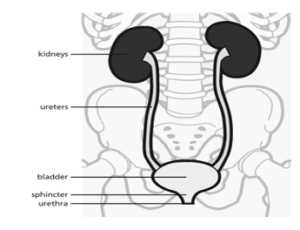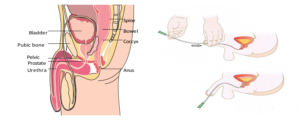How does the urinary system work?
The urinary system consists of the kidneys, the bladder, the ureters and the urethra. The kidneys filter the blood to remove waste products and form urine. The urine flows from the kidneys, down through the ureters to the bladder. From here it passes through another tube called the urethra to the outside when urinating (weeing/peeing).
What is clean intermittent catheterisation?
Clean intermittent catheterisation is a way of emptying the bladder of urine if weeing is difficult or impossible. It involves passing a catheter (thin, plastic tube) through the urethra into the bladder and then removing once the bladder is empty. Good hygiene is extremely important in clean intermittent catheterisation as it reduces the risk of developing a bladder infection.
Why does my child need to have clean intermittent catheterisation (CIC)?
Your child’s Consultant and Urology Nurse will explain the reasons, some possible reasons:

What are the benefits of clean intermittent catheterisation?
By regularly emptying the bladder CIC can help prevent growth of bacteria in the bladder and protect your child’s bladder and kidneys from infection and damage. CIC allows the bladder to empty and this may help prevent reflux (backflow) of urine to the kidneys that can cause damage. It can also help a child to improve their continence.
How is a clean intermittent catheter inserted?
The catheter is inserted through the urethra into the bladder to drain the urine. Once the bladder is empty the tube is then removed. This usually takes less than five minutes. This procedure is done using a clean, non-sterile technique. The catheters are single use and disposable.
You and your child will be offered a choice of catheters. Catheters come in different diameters (width) and lengths. The size of the catheter will increase as your child grows. Catheters are available in three lengths paediatric, male and female.
How often will my child need to have clean intermittent catheterisation?
It will vary according to how much urine your child passes normally and how much urine they leave in their bladder. Your child’s Consultant/Urology Nurse will discuss the frequency of catheterisation with you. Normally CIC is performed every 4 hours from first thing in the morning until bedtime. Some children may need catheterisation overnight.
Equipment you will need:
Catheters can be pre-lubricated (coated with lubricating gel), self-lubricated (they become slippery when soaked in water) or non-lubricated.
Catheters are usually supplied by a home care company so remember to re-order new supplies in plenty of time. If you have any problems getting hold of supplies, please tell us.
Most catheters are disposable ‘single use’ catheters. Please do not re-use single use catheters as it can increase the risk of infection. Used catheters can be disposed of in your household rubbish.
If you are going abroad on holiday, it can be helpful to carry a letter from your child’s consultant explaining why you are carrying catheters. Remember to keep a few days’ supply in your hand luggage just in case your suitcases go astray.
Instructions of how to practice CIC

You should check the amount, colour and smell of your child’s urine. If your child’s urine is dark in colour they may need to drink more. If your child’s urine is offensive smelling they may have a urinary tract infection and you should contact your child’s doctor or nurse for advice.
What are the risks of my child having clean intermittent catheterisation?
All children who are catheterised will have a small amount of bacteria in their urine. Antibiotic treatment is only prescribed if your child becomes unwell with symptoms of urinary tract infection.
Symptoms of urinary tract infection include:
If your child has any of these symptoms it is important to seek medical advice as soon as possible. A sample of urine must be taken before antibiotic treatment is started. Encouraging your child to drink lots of fluids can help prevent urinary tract infection by reducing the amount of bacteria in the urine. Good hygiene, including thorough hand washing before catheterising, is also important.
If it is just a couple of specks of blood, it could mean the lining of the urethra has been scratched during catheterisation. This will settle. If the bleeding is heavy or does not stop you should seek medical advice.
Stricture is a rare complication of CIC. Stricture is a narrowing of the urethra due to scar tissue caused by repeated use of a catheter. The catheters used for CIC are designed to reduce this risk.
Important points to remember about clean intermittent catheterisation
Problem
Cloudy or smelly urine
What to do
This may be a sign of infection
Drinking plenty of fluids will also help.
Problem
Pain when inserting the catheter
What to do
This usually improves in time
If pain continues, talk to your clinical nurse specialist
Problem
Blood in the urine
What to do
This may be a sign of infection
If it does not improve in a few days, talk to your consultant or clinical nurse specialist
For further information please contact
If you have any questions or problems either before or after, please do not hesitate to contact, Urology Clinical Nurse Specialist, on 020 7580 4400, 10838 (09:00-17:00 Monday to Friday).
For Out of hours: Contact our Paediatric Site Practitioner via the switchboard on: 02075804400 ex 10843